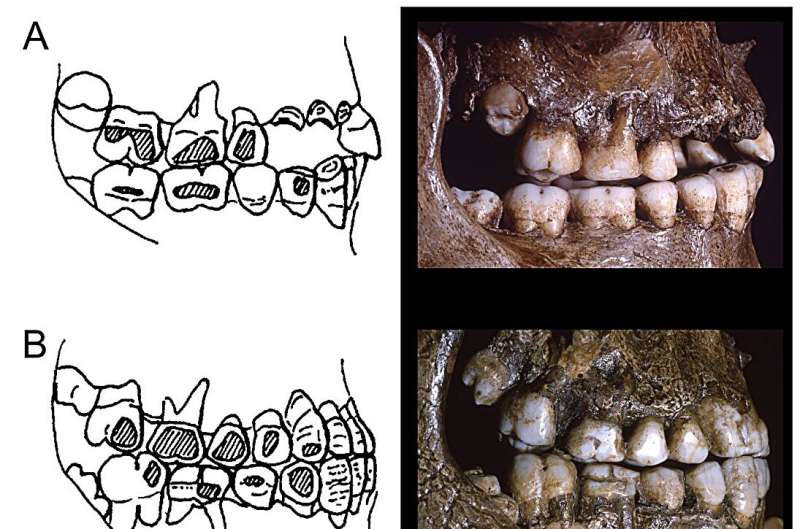A biological anthropologist at the University of Coimbra in Portugal is hypothesizing that the mysterious flat patches found on the sides of teeth in ancient Europeans may have been due to the placement of labrets. In his paper published in the Journal of Paleolithic Archaeology, John Charles Willman describes his study of dozens of ancient teeth with the patches and how he arrived at his conclusion.
Labrets are a certain kind of facial piercing—holes are made in the cheek, close to the mouth and then something is inserted. In modern times, such objects tend to be made of stainless steel. But back during the Paleolithic, they may have been made of wood, leather, or some other material that decayed and disappeared over time.
Archaeologists discovered flat patches on the outer side of teeth in people of the Paleolithic long ago, but they have continued to defy explanation. In this new effort, Willman focused on the teeth of Pavlovian people—a group that lived in parts of Central Europe approximately 25,000 to 29,000 years ago. He looked at dozens of skulls with teeth still intact that have been unearthed over many years. With each, he focused on dental wear.
Prior research has shown that people engaging in behaviors like grinding their teeth together or sucking on pipe stems over long periods tend to develop flat spots on their teeth, similar to those seen on the teeth of the Pavlovian. But there was a big difference: the flat spots on the Pavlovian teeth were on the sides facing the cheek, not the tops.
In studying the flat spots, Willman became convinced they were caused by wear. And the only possible reason for wear on the side, he suggests, is the placement of a labret. He notes that prior research has shown humans have been placing labrets in various parts of their faces for thousands of years. Thus, it would not be surprising to find the Pavlovians participating in such a practice.
Willman also notes that the flat patches appeared on the teeth of children as young as ten, suggesting early use and a possible means for denoting attainment of inclusion in a group, such as an age bracket. He further notes that the flat patches grew bigger as people grew older, suggesting advancement into various groups. He concludes by suggesting that archaeologists begin looking for evidence of labrets at future dig sites to confirm his theory.
More information:
John Charles Willman, Probable Use of Labrets Among the Mid Upper Paleolithic Pavlovian Peoples of Central Europe, Journal of Paleolithic Archaeology (2025). DOI: 10.1007/s41982-024-00204-z
© 2025 Science X Network
Citation:
Flat patches on ancient Europeans’ teeth reveal possible cheek piercing tradition (2025, February 5)
retrieved 5 February 2025
from https://phys.org/news/2025-02-flat-patches-ancient-europeans-teeth.html
This document is subject to copyright. Apart from any fair dealing for the purpose of private study or research, no
part may be reproduced without the written permission. The content is provided for information purposes only.

